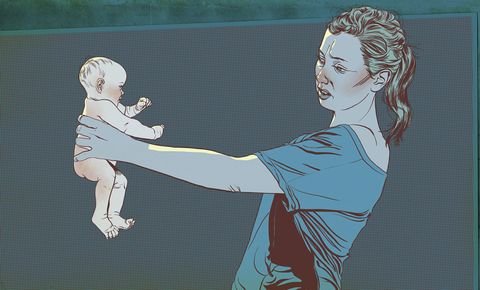The Emotional Roller Coaster Ride after Having a Baby

Sure thing! Giving birth to a child can know no bounds of ‘Happiness for a mother’. This is what we all are fed, we all are taught. But, the picture, in reality, is not so pretty. In fact, many of you are not even acquainted with the word: ‘Post-partum Depression’.
For most new mothers, the first several days after having a baby is an emotional roller coaster ride. There are moments of happiness and joy but there can be rounds of instances filled with depressive symptoms including weeping, anxiety, anger, and sadness. This dual side counts for another term ‘Postpartum psychosis’.
Postpartum psychosis is a severe illness that shows similarities to bipolar disorder (e.g. an elated or depressed mood that can cycle rapidly, irritability, hallucinations, or delusions). It usually presents in the days or weeks after childbirth.
Post-natal Depression:
By definition, it is the first cycle of the monthly period after the mother gives birth. A postpartum period begins immediately after the birth of a child as the mother's body, including hormone levels and uterus size, returns to a non-pregnant state. The terms puerperium or puerperal period, or immediate postpartum period are commonly used to refer to the first six weeks following childbirth.
With around 10% of women experiencing a mental health problem postpartum or during pregnancy, it is important for all healthcare professionals to understand and recognise the risk factors for perinatal mental health problems and know where to refer patients.
Postnatal depression (PND) can begin at any time within one year after delivery. It is a relatively common condition that reportedly occurs in around 10–15% of women following childbirth and around 10% of new fathers; although it is thought that the true prevalence is higher than this.
PND can also occur following miscarriage, stillbirth, or in parents who adopt a child. In England, it is thought that particular ethnic groups. For e.g. Asian women and women from a non-English speaking background) may be affected to a greater extent. This is possibly owing to cultural beliefs around depression, lack of integration, and language barriers making it difficult to express difficulties in the postnatal period.
Causes:
Though it is hard to place a particular reason, it is thought that the abrupt decrease in hormone levels after having a baby can lead to the development of postpartum depression in susceptible women.
One of the strongest predictors of postpartum depression is a personal history of a mood disorder or anxiety, especially if present and untreated during pregnancy. In fact, women with a history of depression during pregnancy are seven times more likely to experience significant postpartum depression. Other factors that may contribute to postpartum depression include social stressors including poor family support and financial concern.
Typically, the symptoms develop within 4 to 6 weeks after giving birth, but it can sometimes take several months to appear.
Symptoms:
- Difficulty bonding with your baby
- Withdrawing from family and friends
- Loss of appetite or eating much more than usual
- Inability to sleep (insomnia) or sleeping too much
- Overwhelming fatigue or loss of energy
- Reduced interest and pleasure in activities you used to enjoy
- Intense irritability and anger
- Fear that you're not a good mother
- Hopelessness
- Feelings of worthlessness, shame, guilt or inadequacy
- Diminished ability to think clearly, concentrate or make decisions
- Restlessness
- Severe anxiety and panic attacks
- Thoughts of harming yourself or your baby
- Recurrent thoughts of death or suicide
Maternal Suicides:
Official figures of the Health Department say that this year, from April to September, 12 out of 74 maternal deaths were suicides. In October, there were three or more such cases (yet to figure in official list). Last year too, there were about 12 such deaths and in 2017-18 also, some 13 cases of maternal suicides were reported.
Approximately 70% to 80% of women will experience, at a minimum, the ‘baby blues’. Many of these women will experience the more severe condition of postpartum depression or a related condition.
The reported rate of clinical postpartum depression among new mothers is between 10% to 20%. One recent study found that 1 in 7 women may experience PPD in the year after giving birth. When including women who have miscarried or have had a stillbirth, around 900,000 women suffer from postpartum depression annually in the US.
One study found that postpartum depression rates in Asian countries could be at 65% or more among new mothers.
Sadly, it is believed that postpartum depression is much more common than these statistics reveal. Some medical experts believe that the rate of postpartum depression could be at least twice as much than what is actually reported and diagnosed. If symptoms go unreported and untreated, they cannot be accounted for in global health statistics.
Of course, in India- it has its added reasons. Kerala Federation of Obstetrics and Gynaecology, which is in charge of conducting confidential reviews of maternal deaths (CRMD) in the State, has said:
“In the West, post-partum depression is the major cause of maternal suicides. In Kerala, however, most cases of suicides are by young women in their early pregnancy. Social causes — domestic violence, partner’s alcoholism, financial problems, issues in love marriages seems to be the driver here.”
It’s important to understand that these numbers only account for live births. Many women who miscarry or have stillbirths experience postpartum depression symptoms as well.
Another important fact to consider about postpartum depression is that it can affect people from all races, ethnicities, cultures and educational or economic backgrounds.
Treatment:
Recent parents who feel that they are showing PPD symptoms should get in touch with their doctor. Although recovery may sometimes take several months, and in some cases even longer, it is treatable.
The most important step on the road to treating and recovering from PPD is to acknowledge the problem. Family, partners, and the support of close friends can have a major impact on a faster recovery. It is better for the person with PPD to express how she feels to people she can trust, rather than repressing emotions. There is a risk of partners or other loved ones feeling shut out, which can lead to relationship difficulties that add to the PPD.
Self-help groups are beneficial. Not only do they provide access to useful guidance, but they also access to other parents with similar problems, concerns, and symptoms. This may reduce the feeling of isolation.
Despite the growing recognition as a global childbirth-related problem, the importance of detecting and treating it has until recently been largely overlooked in practice. PPD is a serious social issue that includes an increased risk of suicide and infanticide. PPD is often under-diagnosed and untreated; therefore, efforts are needed to make people aware as much and increase the improvement in perinatal mental healthcare.















































